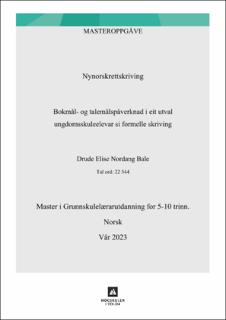| dc.contributor.author | Bale, Drude Elise Nordang | |
| dc.date.accessioned | 2023-07-07T08:22:24Z | |
| dc.date.available | 2023-07-07T08:22:24Z | |
| dc.date.issued | 2023 | |
| dc.identifier.uri | https://hdl.handle.net/11250/3077044 | |
| dc.description.abstract | Formålet med denne masteroppgåva er å undersøkje i kva grad og på kva for måtar bokmål, dialekt/talespråk og dialektnær skriving i sosiale medium er med på å påverke rettskrivinga til eit utval elevar. Undersøkinga er tredelt og består av ei spørjeundersøking, nokre donerte chat-utdrag og ein elevtekstanalyse. Datagrunnlaget består av totalt 18 svar på spørjeundersøkinga, sju innsamla chat-utdrag og 17 elevtekstar. Deltakarane i studien er 9.- og 10.-klassingar frå ein skule i Sogndal kommune, som er eit kjerneområde for nynorsk.
I undersøkinga er det brukt ein kombinasjon av kvantitativ og kvalitativ forskingsmetode, men hovudvekta ligg på det kvantitative. Gjennom spørjeundersøkinga svara elevane på spørsmål, med i hovudsak lukka svaralternativ, knytt til eigen språkpraksis. Det vart så gjennomført ei tekstanalyse av dei donerte chat-utdraga. Og gjennom elevtekstanalysen er avvik frå nynorsknorma registrert inn i ulike avvikskategoriar. Avvika er så plasserte ut frå om dei har samanfall med bokmål, dialekt/talespråk, både bokmål og dialekt/talemål eller ingen av delane.
Resultata frå granskinga syner at 45 % av dei registrerte avvika i elevtekstane har samanfall med (berre) dialekt/talespråk, 24 % har samanfall både med bokmål- og dialekt/talespråk, medan 13 % av avvika fell saman med (berre) bokmål. Resultata frå studien syner såleis at elevar som veks opp i nynorskområde på Vestlandet, både blir påverka av dialektale former som dei brukar når dei snakkar og skriv på sosiale medium, og av bokmål, som dominerer nasjonalt, når dei skal skrive formelle tekstar på nynorsk. | en_US |
| dc.description.abstract | Abstract
The aim of this master’s thesis is to research to what degree, and in what ways Bokmål, dialect/spoken language and dialect-like writing in social media affects the spelling of a selection of pupils. The study is divided into three parts, including one questionnaire survey, some donated chat excerpts, and an analysis of pupil texts. The data consists of a total of 18 answers on the questionnaire, seven collected chat excerpts, and 17 pupil texts. The participants in this research study are 9th- and 10th-graders from a school in Sogndal municipality.
The study consists of a combination of quantitative and qualitative research methods, with the primary focus being on the quantitative aspect. Through the questionnaire survey, the pupils answered questions mainly with closed response options, related to their own language practices. A text-analysis of the donated chat excerpts was then conducted. Additionally, through the analysis of the pupil texts, deviations from the norms of Nynorsk were identified and categorized into different deviation categories. The deviations were then classified based on their correspondence with Bokmål, dialect/spoken language, both Bokmål and dialect/spoken language, or neither.
The results from the research study shows that 45% of the registered deviations in the pupil texts correspond with (only) dialect/spoken language, 24% correspond with both Bokmål and dialect/spoken language, while 13% of the deviations correspond with (only) Bokmål. The results of the research study therefore indicates that pupils who grow up in the Nynorsk-area of Western Norway, are influenced by dialectal forms that they use when they speak and write on social media, and by Bokmål, the dominating writing-language on the national level, when they write formal texts in Nynorsk. | en_US |
| dc.language.iso | nno | en_US |
| dc.publisher | Høgskulen i Volda | en_US |
| dc.subject | rettskriving | en_US |
| dc.subject | talespråk | en_US |
| dc.subject | dialekt | en_US |
| dc.subject | sosiale media | en_US |
| dc.subject | elevtekst | en_US |
| dc.subject | nynorsk | en_US |
| dc.title | Nynorskrettskriving. Bokmål- og talemålspåverknad i eit utval ungdomsskuleelevar si formelle skriving | en_US |
| dc.type | Master thesis | en_US |
| dc.source.pagenumber | 79 | en_US |
